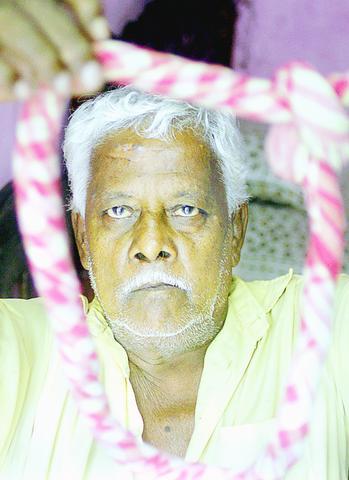He retired after carrying out India's first execution in nearly a decade, but Calcutta's veteran hangman is still in the business. He is selling strands of his final noose -- rumored to have magical powers -- and finding both a ready market and revulsion.
Nata Mallick, 83, ended his career on August 14 when he hanged Dhananjoy Chatterjee, an apartment guard convicted in the rape and murder of a teenaged girl.

PHOTO: AFP
He has since cashed in on a superstition that a hangman's noose possesses occult powers that can uplift the sick and poor. For a price, Mallick sells lockets made from snippets of the noose that broke Chatterjee's neck.
"He is pure evil," Sujato Bhadro, secretary of the anti-death penalty Association for the Protection of Democratic Rights, said of the hangman.
"This sinful man has no right to do this in Calcutta where saints like Mother Teresa worked for hundreds who had given up hope to live," Bhadro said, referring to the Albanian-born nun who was beatified last year.
Mallick, who has hanged 25 people, shrugs off the criticism at his new-found trade.
"It is a proven fact that a used noose has magic power and it works miracles for those having a spate of bad luck, flopped business and heavy debt," the retired executioner told reporters. He says he accepts whatever money is offered him for a noose-locket. And he has plenty to sell.
Mallick has chopped up Chatterjee's noose into miniscule pieces, ensuring there are plenty to sell. For those who don't want to splurge on the freshly used noose, old ropes are also available, Mallick said.
"I collected all the nooses that were lying in the jail when I went there to execute Dhananjoy Chatterjee," Mallick said.
He said he would sell lockets from Chatterjee's noose for around 2,000 rupees (US$43). Lockets from the old ropes, which, as for the Indian prison manual, are each six meters long were 500 rupees (US$11). Mallick had a salary of 5,000 rupees (US$110) per execution, although his fee was doubled for his finale this month.
Among the buyers was Joyprakash Mitra, an unemployed 30-year-old whose grandfather advised him to carry a noose-locket.
"I tried my luck with many things. Now I want to try the magic power of the noose," said Mitra, who declined to say how much he paid.
The hangman claims that hundreds of buyers had come to him. While the number could not be verified, Babu Roy, who owns a tea stall on the road to Mallick's ramshackle house, said the crowds had been significant.
"My daily sales have doubled as people are stopping by my shop while going to meet Mallick," Roy said.
"This rope locket has become a new craze," he said. "They are becoming costlier by the day."
Others are less amused. Ajoy Banerjee of Calcutta's revered Kalighat temple called the trade "sordid."
"His aim is just to earn money," said Banerjee, the secretary of the temple management board, who said the Hindu clergy at Kalighat planned a campaign against the lockets. "We are worried that scores of unwed women and jobless youths are thronging the hangman's home for rope lockets," Banerjee said.
Mallick's outspoken passion for his job helped fuel criticism in the run-up to his last execution. A jail official said Mallick fell ill at the gallows and was carried away on a stretcher after the hanging.
The official claimed that Mallick may have had too many drinks.

DOUBLE-MURDER CASE: The officer told the dispatcher he would check the locations of the callers, but instead headed to a pizzeria, remaining there for about an hour A New Jersey officer has been charged with misconduct after prosecutors said he did not quickly respond to and properly investigate reports of a shooting that turned out to be a double murder, instead allegedly stopping at an ATM and pizzeria. Franklin Township Police Sergeant Kevin Bollaro was the on-duty officer on the evening of Aug. 1, when police received 911 calls reporting gunshots and screaming in Pittstown, about 96km from Manhattan in central New Jersey, Hunterdon County Prosecutor Renee Robeson’s office said. However, rather than responding immediately, prosecutors said GPS data and surveillance video showed Bollaro drove about 3km

‘MOTHER’ OF THAILAND: In her glamorous heyday in the 1960s, former Thai queen Sirikit mingled with US presidents and superstars such as Elvis Presley The year-long funeral ceremony of former Thai queen Sirikit started yesterday, with grieving royalists set to salute the procession bringing her body to lie in state at Bangkok’s Grand Palace. Members of the royal family are venerated in Thailand, treated by many as semi-divine figures, and lavished with glowing media coverage and gold-adorned portraits hanging in public spaces and private homes nationwide. Sirikit, the mother of Thai King Vajiralongkorn and widow of the nation’s longest-reigning monarch, died late on Friday at the age of 93. Black-and-white tributes to the royal matriarch are being beamed onto towering digital advertizing billboards, on

Tens of thousands of people on Saturday took to the streets of Spain’s eastern city of Valencia to mark the first anniversary of floods that killed 229 people and to denounce the handling of the disaster. Demonstrators, many carrying photos of the victims, called on regional government head Carlos Mazon to resign over what they said was the slow response to one of Europe’s deadliest natural disasters in decades. “People are still really angry,” said Rosa Cerros, a 42-year-old government worker who took part with her husband and two young daughters. “Why weren’t people evacuated? Its incomprehensible,” she said. Mazon’s

POWER ABUSE WORRY: Some people warned that the broad language of the treaty could lead to overreach by authorities and enable the repression of government critics Countries signed their first UN treaty targeting cybercrime in Hanoi yesterday, despite opposition from an unlikely band of tech companies and rights groups warning of expanded state surveillance. The new global legal framework aims to bolster international cooperation to fight digital crimes, from child pornography to transnational cyberscams and money laundering. More than 60 countries signed the declaration, which means it would go into force once ratified by those states. UN Secretary-General Antonio Guterres described the signing as an “important milestone,” and that it was “only the beginning.” “Every day, sophisticated scams destroy families, steal migrants and drain billions of dollars from our economy...